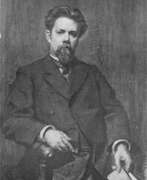Parade portrait Academism


Nikolay Gustavovich Schilder (Russian: Николай Густавович Шильдер) was a Russian painter known for his genre and battle scenes. Born in 1828 in Kharkiv, Schilder became an influential figure in Russian art. He studied at the Imperial Academy of Arts and was influenced by the works of Pavel Fedotov, which led him to focus on genre painting.
Schilder's notable works include "The Temptation" (1857), "Family Happiness" (1858), and "The Repayment of Creditors" (1861), the latter earning him the title of academician. His detailed and emotive portrayal of everyday life and historical events made his works highly regarded in art circles.
Several of his paintings, including portraits of prominent figures such as Alexander III and Maria Feodorovna, are displayed in museums like the State Russian Museum and the Orsay Museum in Paris.
Stay updated on new sales and auction events related to Nikolay Gustavovich Schilder by signing up for our updates.


Sergey Konstantinovich Zaryanko (Russian: Сергей Константинович Зарянко) was a distinguished Russian portrait painter and art educator of Belarusian descent, renowned for his exceptional ability to capture the essence of his subjects with striking realism and meticulous detail. Born on September 24, 1818, in the village of Lyady in the Mogilyov Province, Zaryanko was originally the son of a serf. His early exposure to art came after his family gained freedom and moved to Saint Petersburg, where he began informal studies at the Imperial Academy of Arts in 1834 under the mentorship of Alexey Venetsianov.
Zaryanko's career flourished after he achieved the status of Academician in 1843 and subsequently became a professor at the Moscow School of Painting, Sculpture, and Architecture. His works are notable for their vivid portrayal of characters and the use of light and shadow to enhance the textural qualities of materials like velvet and satin. Among his famous works are portraits of Fyodor Tolstoy and Natalia Sergeyevna Zaryanko, his daughter, which reflect his skill in portraying personal and emotive qualities.
His contributions extended beyond painting to include significant theoretical works on art and teaching methods. Despite the changing artistic trends towards critical realism in the late 19th century, Zaryanko remained faithful to his classical style, which eventually led to a decline in his popularity before his death on December 20, 1870, in Moscow.
If you're captivated by the artistry and historical significance of Sergey Konstantinovich Zaryanko's works, consider signing up for updates from leading art galleries and auction houses. Stay informed about upcoming exhibitions and exclusive sales opportunities that feature Zaryanko's masterpieces. Subscribe today to ensure you never miss an event or the chance to acquire a piece of art history.

